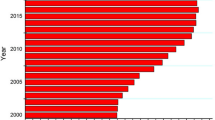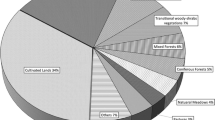Abstract
Until the end of the nineteenth century primary forests covered nearly all the island of Sumatra. The first valorisation of this natural resource was hunting and gathering activities, followed by and later associated with swidden cultivation of upland rice. The industrial revolution in Europe and North America in the 1950s created increasing demand for rubber. Answering this new market opportunity, farmers introduced rubber seedlings in their swiddens amidst the upland rice. By doing so, they invented a new cropping system, i.e. rubber agroforests. Thanks to the continuously increasing demand for rubber by the developing industry, rubber agroforests spread over Sumatra’s eastern peneplains until the 1990s. Forest conversion to rubber agroforests conserves a high level of forest biodiversity and the agroforests act as a buffer zone around national parks. But with growing demographic pressure, market integration and household monetary needs, agroforests are increasingly endangered. New cropping systems have appeared and challenge agroforests’ dominance in the landscape. Since the mid-twentieth century, rubber monospecific plantations have been competing for land, with an undoubtedly higher profitability than agroforests. More recently, oil palm plantations have spread over the island, quickly becoming the new challenger to rubber agroforestry. Nevertheless, the international community shows more and more interest in forest and biodiversity conservation. Forest cover in Jambi province has nearly disappeared over the past 30 years. The only way to save the remnants of forests and agroforests seems to be the creation of market incentives through conservation programs such as reducing emissions from deforestation and degradation.
Similar content being viewed by others
References
Angelsen A (ed) (2008) Moving ahead with REDD; issues, options and implications. CIFOR, Bogor, Indonesia
Ashley R, Russel D, Shallow B (2006) The policy terrain in protected area landscapes: challenges for agroforestry in integrated landscape conservation. Biodivers Conserv 15(2):663–689. doi:10.1007/s10531-005-2100-x
Berkes F, Colding J, Folke C (2000) Rediscovery of traditional ecological knowledge as adaptative management. Ecol Appl 10(5):1251–1262. doi:10.1890/1051-0761(2000)010[1251:ROTEKA]2.0.CO;2
Beukema H, Danielsen F, Vincent G, Hardiwinoto S, Andel J (2007) Plant and bird diversity in rubber agroforests in the lowlands of Sumatra, Indonesia. Agrofor Syst 70(3):217–242. doi:10.1007/s10457-007-9037-x
Casson A (2000) The hesitant boom: Indonesia’s oil palm sub-sector in an era of economic crisis and political change. In: CIFOR (ed) Occasional paper 29, CIFOR, Bogor, Indonesia
Chambon B (2001) De l’innovation technique dans les sociétés paysannes: la diffusion de la monoculture clonale d’hévéa à Kalimantan Ouest (Indonésie). Doctoral diss., Université Montpellier I, Montpellier, France
Colfer CJP, Resosudarmo IAP (eds) (2002) Which way forward? People, forests, and policymaking in Indonesia. Resources for the future. CIFOR, Bogor, Indonesia, and Institute of Southeast Asian Studies (Singapore), Washington, DC
Cunningham A, Belcher B, Campbell B (eds) (2005) Carving out a future: forests, livelihoods and the international woodcarving trade. Earthscan, London
De Foresta H (2008) Forêts et foresteries dans les regions tropicales. In: Hallé F, Lieutaghi P (eds) Aux origins des plantes, vol 2. Editions Fayard, Paris, pp 138–155
De Koninck R (2005) L’Asie du Sud-Est, 2nd edn. Armand Colin, Paris
Dove MR (1994) Transition from native forest rubbers to Hevea brasiliensis (Euphorbiaceae) among tribal smallholders in Borneo. Econ Bot 48(4):382–396
Ekadinata A, Vincent G (2004) Assessing landcover dynamics in Bungo district, Jambi, using multitemporal satellite imagery. SAU Working Document, vol 12, pp 1–29
FAO (2008) FAOSTAT online statistical service. Food and Agriculture Organization of the United Nations. http://faostat.fao.org/. Accessed December 2008
Gadgil M, Olsson P, Berkes F, Folke C (2003) Exploring the role of local ecological knowledge for ecosystem management: three case studies. In: Berkes F, Colding J, Folke C (eds) Navigating social-ecological systems: building resilience for complexity and change. Cambridge University Press, Cambridge
Gouyon A (1995) Paysannerie et hévéaculture dans les plaines orientales de Sumatra: quel avenir pour un système agroforestier. Doctoral diss., Institut National d’Agronomie Paris-Grignon, Paris
Gouyon A, De Foresta H, Levang P (1993) Does jungle rubber deserve its name? An analysis of rubber agroforestry systems in southeast Sumatra. Agrofor Syst 22(3):181–206. doi:10.1007/BF00705233
Huxley PA (1999) Tropical agroforestry. Blackwell Science, Oxford
Joshi L et al (2002) Jungle rubber: a traditional agroforestry system under pressure. ICRAF, Bogor
Le Fèvre G (1927) L’épopée du caoutchouc. Stock, Paris
Levang P (1991) Les agroforêts indonésiennes, contribution de l’agro-économiste. In: IRD (ed) Communication à l’atelier agroforesterie. IRD, Montpellier
Levang P (1997) La terre d’en face: la transmigration en Indonésie. Editions de l’ORSTOM, Montpellier
Levang P, Gouyon A (1993) De la retouche à la rupture: l’introduction de l’hévéa dans les systèmes de riziculture sur brûlis à Sumatra. Séminaire sur “Innovations et sociétés”. IRD, Montpellier
Levang P, Sitorus S (2006) Rubber smallholders versus acacia growers: socio-economic survey of the Rambang Dangku sub-district (South Sumatra). IRD-CIFOR, Bogor
Levang P, Michon G, de Foresta H (1997) Agriculture forestière ou agroforesterie? Bois Forets Tropiques 251(1):29–41
Michon G (2005) Domesticating forests: how farmers manage forest resources. IRD, CIFOR, ICRAF, Bogor, Indonesia
Michon G, Bompard J-M (1987) Agroforesteries indonésiennes: contributions paysannes à la conservation des forêts naturelles et de leurs ressources. Rev Ecol (Terre Vie) 42(1):3–37
Michon G, De Foresta H (1997) Agroforests: pre-domestication of forest trees or true domestication of forest ecosystems? Neth J Agric Sci 45(4):451–462
Michon G, Mary F, Bompard J-M (1986) Multistoried agroforestry garden system in west Sumatra, Indonesia. Agrofor Syst 4:315–338. doi:10.1007/BF00048106
Michon G, De Foresta H, Levang P (1995) Stratégies agroforestières paysannes et développement durable: les agroforêts à damar de Sumatra. Natures Sci Soc 3(3):207–221
Nurrochmat DR (2005) The impacts of regional autonomy on political dynamics, socio-economics and forest degradation: case of Jambi, Indonesia. Doctoral thesis, Goettingen University, Germany
Penot E (2001) Stratégies paysannes et évolution des savoirs: l’hévéaculture agroforestière indonésienne. Doctoral diss., Université Montpellier I, Montpellier, France
Rasnovi S (2006) Ekologi regenerasi tumbuhan berkayu pada system agroforest karet. Doctoral thesis, Institut Pertanian Bogor, Bogor, Indonesia
Ruf F, Lançon F (eds) (2004) From slash and burn to replanting: green revolutions in the Indonesian uplands. The World Bank, New York
Ruiz-Perez M et al (2004) Markets drive the specialization strategies of forest peoples. Ecol Soc 9(2):1–23
Sandker M, Suwarno A, Campbell BM (2007) Will forests remain in the face of oil palm expansion? Simulating change in Malinau, Indonesia. Ecol Soc 13(1):1–18
Thiollay J-M (1995) The role of traditional agroforests in the conservation of rain forest bird diversity in Sumatra. Conserv Biol 9(2):335–353. doi:10.1046/j.1523-1739.1995.9020335.x
Tomich TP, Thomas DE, Van Noordwijk M (2004) Environmental services and land use change: bridging the gap between policy and research in Southeast Asia. Agric Ecosyst Environ 104(1):229–244
Acknowledgements
This study is part of the project Integrating Livelihoods and Multiple Biodiversity Values in Landscape Mosaics, a joint research project of the Center for International Forestry Research and the World Agroforestry Centre, with support from the Swiss Agency for Development and Cooperation.
Author information
Authors and Affiliations
Corresponding author
Rights and permissions
About this article
Cite this article
Feintrenie, L., Levang, P. Sumatra’s Rubber Agroforests: Advent, Rise and Fall of a Sustainable Cropping System. Small-scale Forestry 8, 323–335 (2009). https://doi.org/10.1007/s11842-009-9086-2
Received:
Accepted:
Published:
Issue Date:
DOI: https://doi.org/10.1007/s11842-009-9086-2




